What is Bitcoin integration?
The Internet Computer (ICP) integrates with the Bitcoin network at a protocol level. This means ICP canister smart contracts can create Bitcoin addresses as well as send and receive bitcoin directly on the Bitcoin network. And, Bitcoin can easily and securely be incorporated into DeFi and Web3 services on the Internet Computer blockchain, without having to trust centralized bridging services, which are at high risk of being taken down or hacked.
This integration with the Bitcoin network is made up of two key building blocks: Network integration and chain-key ECDSA. Combining these building blocks, canisters can directly and securely hold, receive, and send bitcoin seamlessly as if the Internet Computer and the Bitcoin network were one blockchain. Another way of looking at it, is that the Bitcoin integration is the same as running a Bitcoin node on chain.






